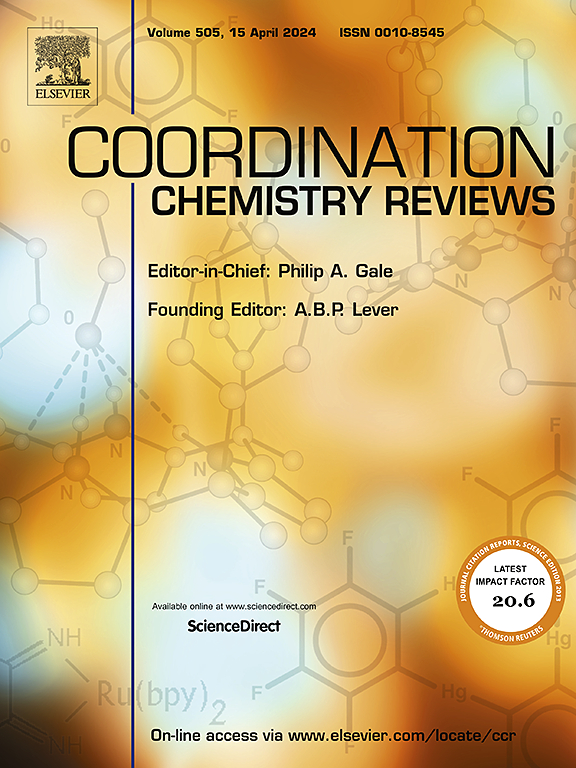Correlating structure-activity-stability relationship of high-valent 3d-metal-based MOFs and MOF-derived materials for electrochemical energy conversion and storage
IF 23.5
1区 化学
Q1 CHEMISTRY, INORGANIC & NUCLEAR
引用次数: 0
Abstract
The energy crises and environmental pollution are the current main challenges for society. In this regard, efficient electrochemical energy conversion and storage technologies could be a promising solution to overcome these challenges. In the past few years, metal-organic frameworks (MOFs) and their derived materials have emerged as potential candidates for energy conversion and storage owing to their finely tuned structural and electronic properties, 3D morphology, large surface area, abundant active sites, good stability, and improved mass transport and diffusion. Among the thousands of MOFs reported in the literature, most are prepared using divalent 3d-metals (i.e., Fe2+, Co2+, Ni2+, Cu2+, and Zn2+) with a combination of various organic linkers. In contrast, MOFs based on high-valent 3d metals, such as Ti, V, Cr, and Mn are less studied but have shown promise in energy conversion and storage. The high-valent 3d-metal-based MOFs offer easier synthesis, facile charge, and mass transport, tunable electronic properties, and high synergistic effects. Although many reviews have been published in recent years, none have focused on high-valent 3d-metal-based MOFs and their usage in energy conversion and storage. The current review summarizes the applications of MOFs made from high-valent 3d metals (Ti, V, Cr, and Mn) and their derived materials. This review focuses on the structure, porosity, and stability of high-valent 3d-metal-based MOFs and MOF-derived materials with their application in energy conversion and storage. Taking into account pioneering reports, this review offers a deeper comprehension and insight into the characteristics and uses of high-valent 3d-metal-based MOFs and MOF-derived materials. The recent progress, challenges related to the field, and the structure-activity-stability correlation have been established with plausible prospects.
用于电化学能量转换和储存的高价 3d 金属基 MOF 和 MOF 衍生材料的结构-活性-稳定性相关关系
能源危机和环境污染是当前社会面临的主要挑战。在这方面,高效的电化学能量转换和储存技术可能是克服这些挑战的一个有前途的解决方案。在过去几年中,金属有机框架(MOFs)及其衍生材料因其精细的结构和电子特性、三维形态、大比表面积、丰富的活性位点、良好的稳定性以及更佳的质量传输和扩散性,已成为能量转换和存储的潜在候选材料。在文献报道的数以千计的 MOFs 中,大多数都是利用二价 3d 金属(即 Fe2+、Co2+、Ni2+、Cu2+ 和 Zn2+)与各种有机连接剂结合制备的。相比之下,基于高价 3d 金属(如 Ti、V、Cr 和 Mn)的 MOF 研究较少,但在能量转换和储存方面已显示出前景。基于高价 3d 金属的 MOFs 具有合成容易、电荷和质量传输方便、电子特性可调以及协同效应高等特点。虽然近年来发表了许多综述,但没有一篇综述关注高价 3d 金属基 MOFs 及其在能量转换和存储中的应用。本综述总结了由高价 3d 金属(钛、钒、铬和锰)及其衍生材料制成的 MOFs 的应用。本综述侧重于高价 3d 金属基 MOF 及其衍生材料的结构、孔隙率和稳定性,以及它们在能量转换和储存中的应用。本综述结合先驱性报告,对高价三维金属基 MOFs 和 MOF 衍生材料的特性和用途进行了深入的理解和洞察。该领域的最新进展、面临的挑战以及结构-活性-稳定性的相关性均已确定,并具有合理的前景。
本文章由计算机程序翻译,如有差异,请以英文原文为准。
求助全文
约1分钟内获得全文
求助全文
来源期刊

Coordination Chemistry Reviews
化学-无机化学与核化学
CiteScore
34.30
自引率
5.30%
发文量
457
审稿时长
54 days
期刊介绍:
Coordination Chemistry Reviews offers rapid publication of review articles on current and significant topics in coordination chemistry, encompassing organometallic, supramolecular, theoretical, and bioinorganic chemistry. It also covers catalysis, materials chemistry, and metal-organic frameworks from a coordination chemistry perspective. Reviews summarize recent developments or discuss specific techniques, welcoming contributions from both established and emerging researchers.
The journal releases special issues on timely subjects, including those featuring contributions from specific regions or conferences. Occasional full-length book articles are also featured. Additionally, special volumes cover annual reviews of main group chemistry, transition metal group chemistry, and organometallic chemistry. These comprehensive reviews are vital resources for those engaged in coordination chemistry, further establishing Coordination Chemistry Reviews as a hub for insightful surveys in inorganic and physical inorganic chemistry.
 求助内容:
求助内容: 应助结果提醒方式:
应助结果提醒方式:


